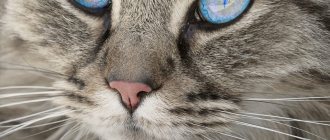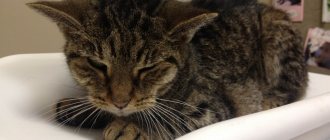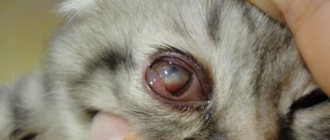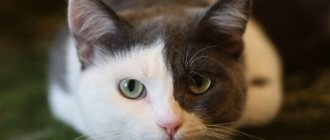Cats became pets tens of thousands of years ago and initially served as a hunter of mice and rats in the home. But gradually it became clear that these animals are able to bestow affection on their owner and create a warm and cozy atmosphere in the house. But the real discovery was feline therapy (therapy with cats) and the fact that there are benefits from communicating with animals. What is this type of therapy and is it as useful as they say.
The effectiveness of treatment in cats
There are hundreds of reliable and proven cases in the world where cats treated people. Most of them concerned the treatment of children with cats who had some characteristics of physical and mental development. The effectiveness of feline therapy has been proven by numerous clinical studies. It provides:
- Positive impact on the health of patients with heart disease.
- Normalization and improvement of the general condition of people after suffering severe injuries, with congenital pathologies of brain functioning.
- Healing from drug and alcohol addiction, depression.
- Assistance in the recovery and rehabilitation of patients with mental disorders. Regular and prolonged communication with the murkas helped to make even those patients who were in an extreme degree of emotional excitement or the deepest depression calmer.
Help in the treatment of mental disorders.
Felinotherapy is one of the best methods of non-drug treatment for people with diseases such as schizophrenia, the presence of various manias and obsessive states.
The most difficult diagnosis to treat is causeless panic attacks. But even with this pathology, the cats successfully coped. As practice shows, at first patients with this disease did not pay attention to the animals, but gradually contact between them was established, the patients became calmer.
Effect on physical condition. Felinotherapy shows good effectiveness not only in the treatment of mental disorders. Frequent and prolonged contact with cats helps to improve the general condition of a person with a variety of diseases. It is a scientifically proven fact that the rumbling of an animal helps to activate the regeneration process at the cellular level.
Using therapy with a cat
Felinotherapy is most often used in the treatment of children. However, it works equally well with adults. Contact with a cat can be beneficial, especially in the case of diseases and disorders such as:
- arthritis,
- autism,
- Alzheimer's disease,
- depression and other mental illnesses,
- muscular dystrophy,
- disability,
- shyness and social withdrawal,
- multiple sclerosis,
- Down syndrome.
Cats cannot help only seriously ill people. But they stimulate the development of children and have a positive effect on their psyche. They also help older people. As scientists confirm, in nursing homes where cats live, patients are in much better condition and, therefore, live longer. The most famous case of a feline therapist is Oscar the cat, a “worker” at a rehabilitation center for the elderly in the United States. The cat sensed the patients' deterioration before this happened and the doctors diagnosed it. Oscar the cat is not the only such case.
Diseases that cats can help treat
Felinotherapy is one of the few alternative treatment methods that is recognized by science. Being near cats and having close contact with them has a positive effect on humans in a number of diseases:
- diseases of the heart muscle and vascular system;
- abnormalities in the functioning of the kidneys and liver, including renal and liver failure;
- viral, infectious diseases, colds;
- neuroses, mental illnesses, panic attacks, mania and depression;
- chronic fatigue syndrome;
- pain symptom of various etiology and localization.
The purring of a cat helps to reduce the intensity of the symptomatic picture of pneumonia, not only alleviating the patient’s condition, but also contributing to his speedy recovery.
Cats and mental health treatment
In psychiatry, cats are sometimes more useful than doctors with extensive experience. Nonsense? No, this is reality. Some psychiatric hospitals specifically provide for the “position of a tailed psychiatrist,” who is on the full payroll of the clinic.
The cat works with each patient individually. The course of feline therapy lasts several months and gives very encouraging results. Probably everyone who has a cat in their home has repeatedly noticed its unique ability to quickly remove a person from a state of stress.
The treatment is based on the cat’s unique ability to establish close emotional contact with the patient. People with mental problems accept the presence of a cat without any signs of distress. The cat doesn’t do anything special, she just sits on the patient’s lap so that he can caress her, licks his hands and face.
This warm lump with a gentle purr has a relaxing effect on the patient. This cat therapy helps people suffering from various types of neuroses, depression and schizophrenia.
Features of the impact on humans
Contact with furry pets can help in the treatment of many diseases and pathological processes. The human body is affected in several ways simultaneously:
- Sound . When stroking its fur, the cat purrs. A pleasant, relaxing sound for humans is produced by animals with a frequency of 16-44 Hz. It is this sound range that is most pleasant and useful for humans. Thanks to it, the immune system is activated, the body’s protective functions are increased, which promotes rapid recovery from viral and infectious diseases. If for some reason a person does not have the opportunity to communicate directly with an animal, for example, if there is an allergy to wool, feline therapy sessions can be carried out by listening to a recording of a cat purring.
- Warm . The animal’s body temperature is higher than that of humans – from +38°C to +39°C. Holding a cat in your arms helps the body and nervous system relax, providing an anti-inflammatory, calming and warming effect. Exposure to heat has a positive effect on a person’s condition in many diseases.
- Energy . Cats absorb negative energy surrounding humans. This means that purrs eliminate the destructive effect of negative energy on a person. For this reason, cats lie down on the owner's place where it hurts. After all, this is where the source of negative energy is concentrated.
According to numerous studies, people who keep cats as pets are less likely to get colds and have a more stable emotional and mental state.
How cats affect human energy
Those who keep a cat in the house know very well that the animal always wants to settle closer to electrical appliances that emit negative vibrations. These fluffies really need negative energy, it directly attracts them. My Toffee always sits on the computer table while I work.
These fluffies feed on negative energy - they are like a plant that feeds on carbon dioxide. When furry faces purr, during this period they encounter negative energy, the sound frequency at this time is about 40 Hz. This very frequency is beneficial for the human body, it is a healing property.
Probably many people have observed their pets: they love to lie on TVs, washing machines, on a table near a computer or near a laptop. But these devices are sources of negative magnetic oscillations.
It turns out that cats are energy vampires; they simply need negative energy.
If a person has a lot of negative, negative energy, the cat tries to absorb it. How can you not love them after such treatment? They can simply fit where a person feels pain.
They do it automatically, not knowing that they are treating and helping. Their main goal is cleansing from negative energy. These animals have strong energy, although by nature they are lazy and selfish. If anyone often experiences depression, then the best solution is to get yourself a cat.
Functions of feline therapy
Catology is a broad science.
Few people know that cats treat oncology, AIDS, and help improve the patient’s condition in immunodeficiency conditions.
Felinotherapy performs numerous functions:
- Psychophysiological – communication with a cat helps to increase the body’s resistance to stressful factors and situations. The risk of depression is reduced. Neurological mental disorders are eliminated.
- Rehabilitation - felinotherapy shows high effectiveness in treating patients with such a deviation as sociopathy. Cats help with repeated rehabilitation. Murka for people with sociopathy serves as a translator, helping in communication with the outside world. Such possibilities of feline therapy make it indispensable for the treatment and rehabilitation of children with autism. Contact with dogs is often used in the treatment of autism. But they need to be prepared for a long time and carefully to communicate with such children, unlike cats.
- Psychotherapy . Many patients with mental disorders do not trust doctors, as a result of which the effectiveness of prescribed treatment is reduced. Cats are calming and help develop trust in people. If a patient has problems communicating with doctors, pets will help him calm down and tune in to open communication with doctors.
- Feeling of importance and worth. Many patients need to feel needed in order to recover and recover. This can be achieved through communication with cats. Caring for a pet develops in a person a sense of importance, worthiness and necessity. This function of feline therapy helps in the fight against depression and suicidal tendencies.
How to start treatment on your own?
global $ads_google;
//data-ad-slot=”2475549904″ $ads_google = empty($ads_google) ? false : true; ?> if ($ads_google == false) {?> $ads_google = true; ?> } ?> Many people have cats at home, whose abilities they are not even aware of. To use your pet for medicinal purposes, you need to remember simple rules. The cat should be cheerful and calm, fed and in a good mood. The better she is located towards you, the better the healing effect.
If you need to cope with neurosis or other similar diseases, the best time for therapy is the evening. To solve heart problems, choose a time to communicate with your cat during the day. To overcome problems in the functioning of the respiratory system, you need to devote a few minutes to feline therapy in the morning.
If you have a cat in your house, use its abilities to get rid of various ailments. Unobtrusive communication with your tailed pet every day will become a pleasant tradition not only for you, but also for the animal.
Felinotherapy methods
Based on the patient’s diagnosis and the severity of the clinical picture, one or several methods of feline therapy can be used for treatment:
- Undirected - living with a cat and regular contact with it. In this case, the patient is constantly monitored. Observations show how willingly a person makes contact with a pet, and how positively this affects his health. If there are improvements, felinotherapy may be the only method of therapy without the introduction of drug treatment.
- Semi-directed - the technique is used if the patient refuses to make contact with the animal. Semi-directed feline therapy is a method of prompting. The patient observes how other people communicate with pets, play with them, while their psycho-emotional state improves before their eyes. In this case, feline therapy is not imposed on the patient, and doctors simply observe how the patient observes other people interacting with cats. Specially trained cats are used to carry out the semi-directed therapy technique. Trained animals themselves know when it is possible and necessary to approach a person, and when it is recommended to limit communication. The goal of semi-directed feline therapy is to unobtrusively prepare the patient for communication with animals and gradually establish open contact with them.
- Directed – this method is suitable if the patient willingly makes contact with the animal. Treatment uses not only live pets, but also their images and figurines made of various materials. Conducting targeted feline therapy involves the use of only specially trained animals. Each cat performs its own functions and tasks in communicating with the patient.
Felinotherapy. What and how do cats treat?
For the past 10 thousand years, cats have been traditional companions of humans. In the process of taming and domestication back in the Stone Age, the ability of small “purrs” to successfully destroy eternal pests - colonies of rats and mice - was noted and highly appreciated. In addition, it is not uncommon for an ordinary domestic cat living in rural areas to act as a shepherd and protector of a poultry yard.
Already in later times, the capabilities of cats were somewhat overestimated. Observing the habits of pets, it became obvious that these animals can relieve some ailments, relieve exacerbations of chronic processes, and also relieve pain.
Which cats are suitable for therapy?
The fact that feline therapy is recognized by traditional science proves the effectiveness of this treatment method. Various animals are used in feline therapy: both specially trained ones and those living directly with the patient.
In order for a cat to be “used” in the treatment of many diseases, it must have the following character traits:
- openness;
- friendliness;
- lack of aggression.
The cat must be mature and physically well developed.
Peculiarities of animal color in feline therapy
Feline therapists select animals to treat patients based on their color and coat type. It is extremely important to choose the right cat for feline therapy to give a positive result:
- With black color - used in the treatment of patients with severe mental disorders. Black cats are better than others at making contact with humans. They have very strong energy and can win over the most difficult patient.
- Color point – animals with this color successfully cope with viral and infectious diseases. They show high effectiveness in the treatment of acute respiratory viral infections, influenza and colds.
- Long hair - pets have a wide range of healing abilities. Long-haired purrs are used in the treatment of patients with mental disorders and insomnia. Animals also help in the treatment of joint pain and various diseases of the musculoskeletal system.
- With thick hair - heal diseases of the heart muscle and vascular system.
- Short-haired cats can cure diseases of the digestive system, kidneys and liver. In the chronic course of these ailments, pets help reduce the frequency of relapses and relieve the unpleasant symptoms of these diseases.
Gender
For the effectiveness of treatment of a particular disease, the gender of the animal plays a huge role. Cats perform much better in the treatment of neurological diseases. They also cope well with psychological disorders.
Males, on the other hand, feel pain of various etiologies more subtly. The effectiveness of male cats is especially high in the treatment of diseases of the musculoskeletal system, spine, and joints.
Treatment of cats
How can you explain the positive impact of cats on human health?
Scientists believe that cats' purring is crucial. As many studies and experiments confirm, purring is a unique therapeutic tool.
How to explain this?
A cat's purr produces vibrations that resemble those used in modern orthopedics to treat fractures and muscle tears. The accompanying murmur of sound affects our brain in a certain way, influences the reduction of perceived stress and releases the hormone of happiness and restful sleep.
How to enhance the effect of feline therapy
In order for a treatment method such as cat therapy to give a positive result, you must adhere to the appropriate rules and medical recommendations:
- The right time . Treatment of diseases of the respiratory system, including pneumonia, is early in the morning - 3-5 hours. The optimal period for treating heart and vascular diseases is during the day, 11-13 hours.
- Choosing the length of the coat . Long-haired pets will help get rid of depression, neuroses, and insomnia. Males and cats with medium length hair are the best choice for people who suffer from disorders of the heart and vascular system.
- Animal color . Black cats will relieve chronic fatigue, red and cream cats will help you gain vitality and strength.
- Choosing the correct sex of the animal . Cats are able to stabilize the neurological and psycho-emotional state, restore peace of mind and harmony. Cats are more focused on physical pain that occurs due to the development of diseases of the musculoskeletal system: radiculitis, arthrosis, arthritis.
- Duration of communication. Contact and interaction with the animal should be daily. The duration of one session is from 10 minutes to 2 hours. If the patient was initially reluctant to contact the pet, communication should be established gradually, and the duration of the first sessions should not exceed more than a few minutes. As a preventive measure, communicating with an animal several times a week is enough.
The most important rule for obtaining a positive result from feline therapy is love and respect for the animal.
Cats very keenly sense a person’s mood and his attitude towards himself. You should not approach a cat if it causes fear or panic. The animal will sense this and begin to behave extremely aggressively towards the person. Communication should take place in a positive mood.
Can cats heal?
Felinotherapy is the result of many years of research by zoologists. They studied the healing abilities of cats and finally identified them, confirming them with scientific works.
As you know, a cat can take away negative energy from a person, which brings him pain. It also helps relieve stress and has a beneficial effect on the nervous system as a whole. But the question may arise: how does an animal feel after taking human ailments into itself? Perhaps it itself begins to suffer? In fact, cats do not cause any harm to their body, but simply successfully process bad energy. Many owners of furry pets noticed for sure when they were in a bad mood, and only by taking the animal on their laps and stroking it, they felt almost instantaneous relief.
A cat is able to sense the mood of its owner and the state of his health, even if some disease is just in its infancy. But in order to achieve a positive effect from feline therapy, a person must treat cats with respect and love.
Nuances of therapy
Felinotherapy, despite the fact that it has shown high effectiveness in the treatment of many diseases, cannot be an independent method of therapy. This is an auxiliary method that should be prescribed exclusively by a doctor. If you have serious illnesses that occur with an acute symptomatic picture, you should not pin all your hopes on communicating with cats.
In addition, it is strictly forbidden to use feline therapy on your own. A positive result will be achieved only if all the nuances of this type of treatment are followed, and only a specialist can do this.
Also watch a video about feline therapy:
How feline therapy works
Cats are able to take away negative energy from a person: that which is received during the day, and especially that which is “emitted” by a diseased organ when it is out of balance with the body. In simple terms, cats treat diseases, trying to “patch up” the energy gaps in our biofield. They are also capable of emitting certain vibrations that have a positive effect on health. These include:
- sound waves,
- vibration waves,
- thermal radiation of an animal,
- weak wave electric current.
Felinotherapy - the principle of treatment
Felinotherapy should be started in the evening, because then the cat is in an alert state. Treatment begins when the animal lies down on the sore spot and begins to purr. After this, you need to relax and just trust the “mustachioed doctor.” After the treating cat finishes the therapy session, she will leave on her own. When he wants or feels that the owner needs more “treatment”, he will certainly come again.
Important: do not force yourself to treat if the animal does not want it. Cats are freedom-loving animals and will not do anything against their will. The cat himself will feel when a person needs another therapy session and will definitely come to the rescue.
What diseases can cats treat - scientific assumptions and real stories
Did people in ancient times know about the healing abilities of cats? Modern scientists do not give a clear answer to this question. It is known that in ancient times cats were valued for their ability to destroy pests, but even here a question arises. Cats are quite restive, they can even scratch their beloved owner, so would they tolerate such nonsense in ancient times? In those days, everyone who could threaten health was destroyed or not allowed close to the settlements, so the conclusion arises that either cats not only caught rodents, or the ancient peoples knew about the abilities of tailed animals.
This is interesting! Even in ancient times, people listened to the natural instinct of cats, which more than once saved bipeds from natural disasters.
Real life story
A cat got into the habit of visiting the house of one middle-aged married couple. The tailed one was not homeless, she obviously came to visit and soon disappeared in an unknown direction. The cat did not bother the family; they even fed the guest with treats. After several visits in a row, the cat disappeared for 4 months and what was the surprise of the spouses when the purring appeared on the doorstep again. She walked into the house as if nothing had happened, got her treat and left again, having spent no more than 40 minutes with her two-legged friends.
The visits of the four-legged guest were repeated every 3-4 months and each time they followed the same scenario. One winter evening, when the husband was relaxing in front of the TV and his wife was busy in the kitchen, a loud, even demanding meow was heard outside the door. Grabbing the treat, the wife hurried to the door, but the cat was not interested in the treats.
The four-legged guest went straight to her husband, carefully climbed into his arms and began to “trample” his chest without releasing her claws. The couple were dumbfounded and silently watched what was happening. The process lasted about 5 minutes, after which the cat jumped to the floor and went through the unlocked door. A day later, at the same time, the man had a heart attack. Everything turned out well, one might say, the man survived, but the cat no longer came to the family’s house.
Therapeutic purring
As a child, for some reason I thought that a cat “sings songs” because she is in a good mood. But later I had to observe cats that could not be classified as “satisfied with life.”
Easy Plugin for AdSense by Unreal
Very often, a sick cat begins to purr quietly. Scientists have found that a cat's purring is a sound signal with an oscillation frequency of 20 to 50 hertz. They help improve the body’s immunity and speed up the healing process for both the cat doctor and his patient.
Doctors have made another very interesting discovery related to the purring of cats. Under the influence of sound vibrations of the “cat song,” bone density increases significantly and the healing of fractures accelerates significantly. The use of cats has been proposed for the prevention and treatment of bone diseases. The use of purr in the treatment of osteoporosis in older people is especially important.
The cat makes a diagnosis
A few years ago, a neighbor's cat got into the habit of visiting us. We did not know her name and began to call her Friendly (Friendly). From the first appearance she immediately made contact. We fed her something tasty, then she disappeared for a long time. Friendly showed up at our house about 2-3 times a year.
I especially remember her last visit in February last year. It was evening, my husband was lying on the sofa watching TV, a loud meow was heard outside - it was our rare guest. I opened the door, Friendly went straight to the sofa, jumped on it, then carefully climbed onto my husband’s chest and began to quickly move his paws. My husband and I looked at each other: the cat was exhibiting some very strange behavior. In this way, Friendly “massaged” her breasts for about five minutes, then abruptly finished, headed to the door and left.
Two days after this, my husband had a heart attack... Probably, Friendly wanted to warn him about the impending danger. Since then the pussy hasn't come to us again.
Cats in history and mythology
In ancient times, the domesticated cat was man's companion and favorite pet. On the territory of Cyprus in the 20th century, burials were found of people who died a natural death and were buried along with their euthanized cat. This suggests that a person in that era wanted to take his four-legged friend to the afterlife.
In Egypt, even before our era, cats were used as hunters of mice, rats and other rodents.
In addition, in the Middle East the animal was considered sacred and inviolable. For killing a pet, a person was sentenced to death. Cats were worshiped, and after death they were mummified in order to be taken to the tomb to their owner.
Editor's Choice: Gray and Yellow Wedding
At different times, among different peoples, cats were the personification of gods and goddesses of fertility, love, and fidelity. They were revered in Ancient Egypt, Rome, and the countries of Scandinavia.
At the same time, in the Middle Ages in Catholic European states, the animal was given a completely different meaning. It was believed that the black cat was a companion of the devil and witches, and this was the basis for burning it at the stake.
In the modern world there is no place left for such mass cruelty, and man loves and takes care of his four-legged companion.










